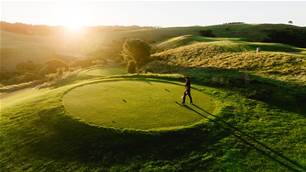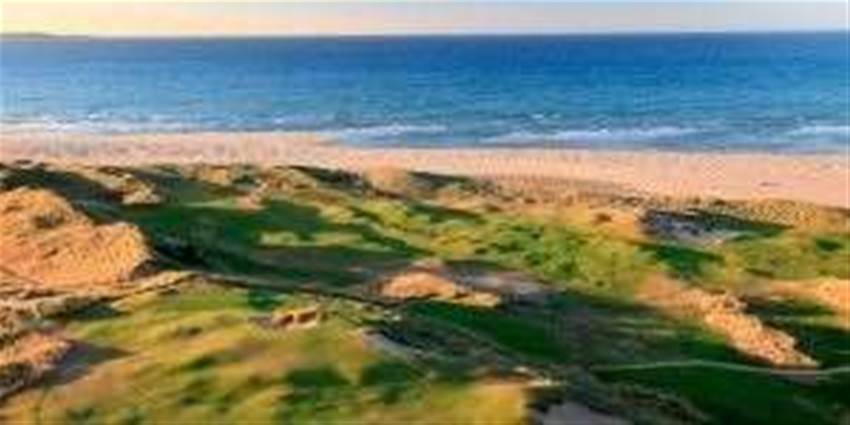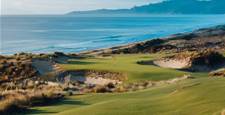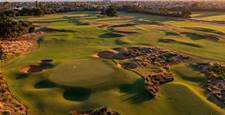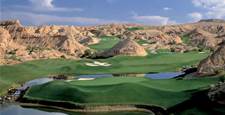Now more than ever, this nation’s golfers are spoilt for choice.
Now more than ever, this nation’s golfers are spoilt for choice. Check out our ranking of the best courses everyone can play.Australia is blessed with hundreds of quality courses, which not only offer a terrific golfing experience but are affordable to play. 
At last count there were approximately 1,700 courses spread throughout the land ranging from the ultra-exclusive city layouts down to the nine-hole sand-scrapes commonly found in rural and outback towns. Within that large number of courses there are private, semi-private and restricted access layouts that are not readily playable for the average golfer.
However, the vast majority of courses welcome visiting golfers – they are public accessible. By our definition, a public access course is one that sets aside tee times for visiting golfers for a minimum of five days a week.
As you follow our ranking through you will note some highly-regarded resort courses, like Magenta Shores and Hyatt Regency Coolum, have been omitted from our public access ranking for the first time. In terms of our public access criteria, they do not qualify because they restrict access to their members and guests of the adjoining resort.
The final ranking was compiled over the past 12 months by Golf Australia editors with the assistance of regular ranking judges as well as a team of committed Golf Australia readers who volunteered to present their opinions and insights. This involved visiting courses, sometimes covertly, and noting any changes to the design as well as the conditioning of the course.
We estimate that there are about 1,100 public access courses in Australia, which means the courses that have made our inaugural top-100 ranking and are featured here, represent the very best courses you can readily play. Enjoy!
1. Barnbougle Dunes
 The course that put north-east Tasmania on the global golfing map now has company in its neighbourhood, but that should only lure more people out to see this monument to pure golf. Working with genuine linksland, architects Doak and Clayton created a layout that embodies the principles of minimalist design – wide, windswept and natural-looking, it evokes the public links upon which the game was founded. Only time will tell if Barnbougle Dunes keeps its No.1 spot with little sister, Lost Farm, now open and already drawing comparisons. There is going to be serious sibling rivalry between this pair in years to come.
The course that put north-east Tasmania on the global golfing map now has company in its neighbourhood, but that should only lure more people out to see this monument to pure golf. Working with genuine linksland, architects Doak and Clayton created a layout that embodies the principles of minimalist design – wide, windswept and natural-looking, it evokes the public links upon which the game was founded. Only time will tell if Barnbougle Dunes keeps its No.1 spot with little sister, Lost Farm, now open and already drawing comparisons. There is going to be serious sibling rivalry between this pair in years to come.
Bridport, Tasmania
Tom Doak & Mike Clayton (2004)
6,148 metres, par-71
GREEN FEES: $98.
CONTACT: (03) 6356 0094;
2. Barnbougle Lost Farm
The much-anticipated second course at Barnbougle, Lost Farm, makes a spectacular entry into this ranking at No.2 and will be a serious contender for the top spot in years is to come. While Lost Farm, like Barnbougle Dunes, is set among dramatic coastal sand dunes, the course is quite different. Coore’s routing hugs the sea where possible but it also takes advantage of the fine golfing landscape found just inland from the beach. This has resulted in a layout that plays to all points of the compass and, with the ever-present wind, makes for a wonderful variety of shots during the course of a round.
Bridport, Tasmania
Bill Coore & Ben Crenshaw (2010)
6,486-metres (20 holes), par-78
GREEN FEE: $98.
CONTACT: (03) 6356 1124.
3. Moonah Links Legends Course

Most of the talk at Moonah Links centres on the “leviathan” (Peter Thomson’s own description) Open course but the Legends layout has proven more popular with our judges. Golf is supposed to be fun and the stunning dunescape, combined with a collection of well designed and playable holes, make the Legends course exactly that.
Fingal, Victoria
Peter Thomson & Ross Perrett (2004)
6,315 metres, par-72
GREEN FEES: $75 (low season), $95 (high season). $150 (all day pass).
CONTACT: (03) 5988 2088; www.moonahlinks.com.au
4. Joondalup CC (Quarry/Dunes course)

The former No.1 resort course in the country narrowly missed grabbing third spot here. The Quarry/Dunes layout at Joondalup is one of the country’s most dramatic inland layouts, with most of its holes being routed around or over an abandoned limestone quarry.
The course offers the ‘wow’ factor in spades from its creative design to the outstanding conditioning of its playing surfaces.
Joondalup CC (Quarry/Dunes course)
Western Australia
Robert Trent Jones (1992)
6,523 metres, par-72
Quarry/Dunes course
GREEN FEE: $135 (Mon-Thurs); $145 (Fri-Sun).
CONTACT: (08) 9400 8812;
5. St Andrews

When Golf Australia last published its Public Access courses ranking in January 2009, St Andrews Beach was not even considered because it was then a private course. Having since closed and then re-opened under new owners and management, St Andrews Beach has been reincarnated as one of the country’s best public access courses. Designed by Tom Doak, the undulating nature of the land that St Andrews Beach covers provides a unique golfing experience with generous fairways and spectacular green complexes. Since reopening in October 2009, the condition of the layout has gone from strength-to-strength. “It’s never looked better,” was a common call from our panel of judges.
St Andrews Beach, Victoria
Tom Doak (2005)
6,420 metres, par-72
GREEN FEE: $59; $79 (peak holiday times). $89 all day pass.
CONTACT: (03) 5988 6000;
6. Thirteenth Beach
This Tony Cashmore-designed gem celebrates its 10th anniversary this year and it is testament to the quality of the layout that has managed to maintain its high standing and improve on its ranking over the years. The Beach course may only be ten years young but it fits in so well with the surrounding dunes that one could be mistaken for thinking this par-72 has been in the ground here for decades. This can be attributed to Cashmore’s highly creative design and a willingness to let the land dictate the location of the tees and greens. The opening four holes don’t really reveal what lies ahead as the layout heads away from the clubhouse again and into the dramatic sand dunes that separate the course from Thirteenth Beach.
Barwon Heads, Victoria
Tony Cashmore (2001)
6,391 metres, par-72
Beach course
GREEN FEE: $59; $79 (peak holiday times).
CONTACT: (03) 5254 2922
7. The Dunes
The Dunes led the wave of development that has turned the Cups region in the middle of the Mornington Peninsula into one of country’s great golfing grounds.
Designer Tony Cashmore fashioned the undulating terrain into a rugged, sprawling tee-to-green test, with the natural bunkering and the odd blind shot punctuating every player’s round here. Dropping two places in the ranking here should not be seen as a slight on The Dunes given the intense competition for spots behind both the Barnbougle Dunes and Lost Farm layouts.
GREEN FEE: $52 (weekdays); $69 (weekends, holidays).
CONTACT: (03) 5985 1334;
8. Bonville
There are few places to play golf that are prettier than among the flooded gums of Bonville, long recognised as one of the most aesthetically pleasing layouts in the country. Course improvements, particularly in the bunkering, continue to progress, complementing the daring quality of its best risk-reward holes, such as the par-5 finisher or the all-or-nothing water carry on the new 17th.
These factors and the improved general conditioning of Bonville, year round, have no doubt contributed to Bonville reaching its highest ever position in this ranking.
Bonville, New South Wales
Terry Watson & Ted Stirling (1992)
6,079 metres, par-72
GREEN FEE: $110 (Mon-Thurs), $125 (Fri-Sun), inc. twin share cart.
CONTACT: (02) 6653 4002
9. Kennedy Bay
When Golf Australia last published its Public Access courses ranking in January 2009, Kennedy Bay was an unfortunate absentee from the pointy end of the list for the first time in several years. Having re-opened under new owners and management nearly two years ago, Kennedy Bay has re-entered the ranking in the top-10 and recaptured its former standing as one of Australia’s premier public access courses.
Kennedy Bay, with its undulating greens, penal pot bunkers and the rippling fairways wedged between vast tracts of native vegetation, is deserving of such high acclaim.
Port Kennedy, Western Australia
Michael Coate, Roger Mackay & Ian Baker-Finch (1998)
6,420 metres, par-72
GREEN FEE: $45 (weekdays), $50 (weekends).
CONTACT: (08) 9524 5991;
10. Brookwater, Queensland
 Brookwater is certainly the most dynamic golf course in the South East Queensland region yet still seems to have a ‘love it’ or ‘hate it’ reputation from its patrons. Many high handicappers, particularly those that venture it off the tips, can’t play anywhere near their handicaps and become frustrated with the place.
Brookwater is certainly the most dynamic golf course in the South East Queensland region yet still seems to have a ‘love it’ or ‘hate it’ reputation from its patrons. Many high handicappers, particularly those that venture it off the tips, can’t play anywhere near their handicaps and become frustrated with the place.
Played off the correct markers (those that match your ability) a round here is very enjoyable. Accuracy is of the paramount importance and if this means keeping the driver in the bag, and positioning a fairway metal or hybrid in the fairway, do it.
Greg Norman & Bob Harrison (2002)
6,505 metres, par-72
GREEN FEE: $120 (Mon-Thurs), $140 (Fri-Sun), inc. cart and range balls.
CONTACT: (07) 3814 5500;
For the top 100 Public Golf Courses please click here.
Related Articles
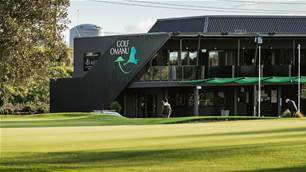
International Spotlight: Omanu Golf Club
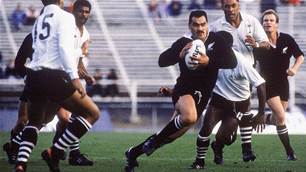
Celebrity Kiwi couple tee off in paradise
